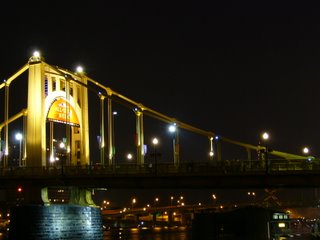
Pre-industrial Pittsburgh is hard to imagine. In fact, it's almost as hard as getting the world to realize we're in post-indutsrial Pittsburgh. We still celebrate our industrial heritage. Smokestack's line the parking lot by the Homestead Waterfront. The U.S. Steel Building still dominates our skyline. Our Steelers, by winning the Superbowl, reminded the world "Pittsburgh" and "Steel" are forever linked.
There is a certain beauty to industry. The smoke, the fire, the molten liquid and the I-beams that now hold up the Empire State Building and the Golden Gate Bridge. Those are pieces of Pittsburgh and they can never be forgotten or removed from our memory.
Yet there is a pre-industrial Pittsburgh that remains to be rediscovered. Before railroads, there were canals, before canals there were trails. Before smoke filled the skies there was clean air and a natural beauty that brought artists here to capture.
We may not notice them, but there are remains and reminders of a pre-industrial era around us. One is a street on Spring Hill named "Hetzel." It's named for the family of "Scalp Level" landscape painter George Hetzel. Today Hetzel's work is well represented by the Westmoreland Museum of Art in Greensburg.
George Hetzel was born in France, but would leave his mark by painting Western Pennsylvania. He lived in Allegheny City and traveled to Johnstown to paint the landscape, long before Steel came to likewise define that city.
If you look closely you may find some buildings that existed in the pre-industrial days of Pittsburgh. Many are found in East Deutschtown, then a German community in the City of Allegheny. Although Hetzel claimed to be French, German was the family's native language (Another claim to Germany, he studied at the Dusseldorf Art Academy).
One such pre-industrial Pittsburgh building is the Block House at the Point. It's unlikely many noticed it in those days, however, and a miracle it survived. Many buildings built during Hetzel's life he may have actually visited also remain standing. Many of these are threatened by years of neglect.
This has been owned for years by PennDot with long-ago dismissed plans of building a 28-279 connector.
Today we're continually faced with the option of embracing our industrial past or rejecting it. Pittsburgh is emerging as a very different post-indutsrial city, yet the Pittsburgh of tomorrow may be able to embrace the natural beauty of our landscape as much as the steel might of our more recent past. So little of pre-industrial Pittsburgh remains to be preserved, however, and what is left isn't well prepared for the future. Even in the City of Allegheny, outside of a few homes on Spring Hill (which don't need preserving), there's little beyond East Deutschtown George Hetzel would recognize. We need to save East Deutschtown before only structures from the age of steel are left to define the history of our city.







